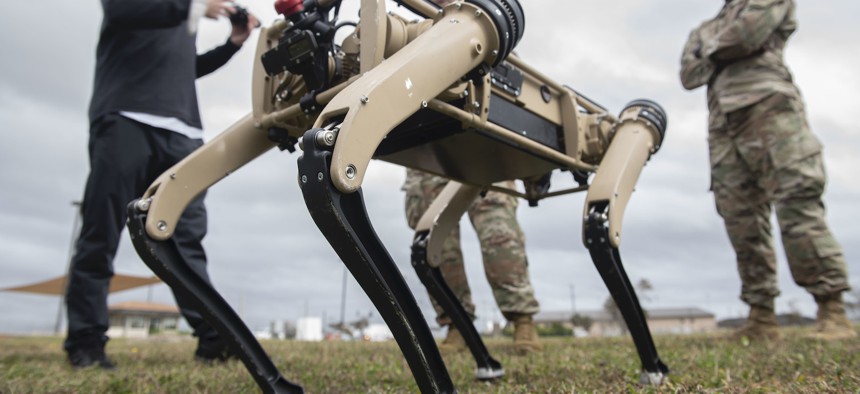
Tyndall Air Force Base, Florida, was is one of the first to implement semi-autonomous unmanned ground vehicles into base security patrols. U.S. Air Force photo by Airman 1 st Class Tiffany Price)
The Near Future of Military Autonomy Isn’t Robotanks, It's ‘Microservices’
Instead of commanding killer robots, most troops will get helping hands from things like driving assistance software.
Robot tanks and drones swarming the battlefield represent only a small fraction of the ways the military might put autonomy to use in the years ahead. Most troops will likely experience autonomy first as a helping hand in various tasks, from making it easier to drive to collecting intelligence to managing base logistics, autonomy experts from industry and the Pentagon said Thursday. And as troops get comfortable with software tools that lighten their loads, they will build trust and familiarity with the fully autonomous hardware that will eventually arrive.
The most important military use of autonomy in the years ahead will be replacing the manned reconnaissance patrols that send troops into danger to scout out the enemy, said Robert Sadowski, the chief roboticist at the Army’s DEVCOM Ground Vehicle Systems Center.
“We really are pushing robots at the vanguard, front of our formations because, right now, commanders trade soldiers, their lives, for information. We can use robotics and autonomous systems to help reduce that,” he said at a National Security Innovation Network event.
But even the private sector doesn’t have fully autonomous fleets of self-driving vehicles yet, despite the availability of machine vision and sensing tools that are impractical for combat settings.
“You cannot use many of the sensors that we'd love to use,” Sadowski said.
For instance, light detection and ranging or LIDAR, is a pretty essential aspect of commercial vehicle autonomy. But on the battlefield, LIDAR means “the bad guys can see me too.”
Sadowski noted that military vehicles don’t even move the same way commercial ones do.
“I also have to be able to be terrain-informed and move at relevant speeds. ‘Relevant speeds’ in a combat scenario can be quick stops and starts,” he said. “All of this requires a sort of level of autonomy that we clearly see is probably not being developed out there in the commercial space.”
Even in that commercial space, fleets of self-driving trucks are still a few years away, said Cory Clothier, who directs the autonomous mobility team at engineering consultancy Stantec.
“Closer to five years for on-road trucking,” Clothier estimated. “But I think what is going to lead the way is more campus-based logistics…There's a use case that the technology can actually handle it now if it's low speed and within a constrained environment.”
Scott Walbrun, a senior associate at BMW i Ventures, pointed out that the venture capital market for autonomy is a lot more diverse than just self-driving cars rolling out of factories. There are also startups specializing in the hardware, like LIDAR or other sensors, and autonomy software companies. The venture capital market has a bias for those software startups because they are less risky, he said.
That bias is playing out in the automotive industry today, with bits and pieces of autonomy creeping in the driving experience in what Jean-Charles Lede, an autonomy technology advisor at the Air Force Research Laboratory, described as “microservices.”
“They are not waiting or designing brand new [autonomous] cars,” Lede said. “They are taking current cars and modifying them, whether it's for testing or for operational use. You can't rent a car today without having some kind of lane assist or, you know, blind-spot checking.”
The U.S. military can start deploying those microservices into systems now—so long as those systems have the open architectures the military wants in future gear. That incremental deployment will affect another big problem that the military has, he predicts, a lot of operators just don’t trust autonomous systems.
“All those are microservices that we can start deploying in platforms can earn the trust and, frankly, verify that it works.”







